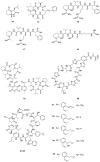Lichen-Derived Actinomycetota: Novel Taxa and Bioactive Metabolites
- PMID: 37108503
- PMCID: PMC10138632
- DOI: 10.3390/ijms24087341
Lichen-Derived Actinomycetota: Novel Taxa and Bioactive Metabolites
Abstract
Actinomycetes are essential sources of numerous bioactive secondary metabolites with diverse chemical and bioactive properties. Lichen ecosystems have piqued the interest of the research community due to their distinct characteristics. Lichen is a symbiont of fungi and algae or cyanobacteria. This review focuses on the novel taxa and diverse bioactive secondary metabolites identified between 1995 and 2022 from cultivable actinomycetota associated with lichens. A total of 25 novel actinomycetota species were reported following studies of lichens. The chemical structures and biological activities of 114 compounds derived from the lichen-associated actinomycetota are also summarized. These secondary metabolites were classified into aromatic amides and amines, diketopiperazines, furanones, indole, isoflavonoids, linear esters and macrolides, peptides, phenolic derivatives, pyridine derivatives, pyrrole derivatives, quinones, and sterols. Their biological activities included anti-inflammatory, antimicrobial, anticancer, cytotoxic, and enzyme-inhibitory actions. In addition, the biosynthetic pathways of several potent bioactive compounds are summarized. Thus, lichen actinomycetes demonstrate exceptional abilities in the discovery of new drug candidates.
Keywords: actinomycetes; antimicrobial; bioactive secondary metabolites; biosynthetic pathways; diversity; lichen.
Conflict of interest statement
The authors declare that they have no known competing financial interests in this paper.
Figures
















Similar articles
-
Antimicrobial activity and biosynthetic potential of cultivable actinomycetes associated with Lichen symbiosis from Qinghai-Tibet Plateau.Microbiol Res. 2021 Mar;244:126652. doi: 10.1016/j.micres.2020.126652. Epub 2020 Dec 1. Microbiol Res. 2021. PMID: 33310352
-
Diversity, Antimicrobial Activity, and Biosynthetic Potential of Cultivable Actinomycetes Associated with Lichen Symbiosis.Microb Ecol. 2017 Oct;74(3):570-584. doi: 10.1007/s00248-017-0972-4. Epub 2017 Mar 30. Microb Ecol. 2017. PMID: 28361265
-
A Review of Anti-Cancer and Related Properties of Lichen-Extracts and Metabolites.Anticancer Agents Med Chem. 2022;22(1):115-142. doi: 10.2174/1871520621666210322094647. Anticancer Agents Med Chem. 2022. PMID: 34225637 Review.
-
Lichen and Its Microbiome as an Untapped Source of Anti-Biofilm Compounds.Chem Biodivers. 2025 Apr;22(4):e202401557. doi: 10.1002/cbdv.202401557. Epub 2024 Dec 20. Chem Biodivers. 2025. PMID: 39602230 Free PMC article. Review.
-
Antiangiogenic properties of lichen secondary metabolites.Phytother Res. 2021 Jun;35(6):3046-3058. doi: 10.1002/ptr.7023. Epub 2021 Feb 15. Phytother Res. 2021. PMID: 33587324 Review.
Cited by
-
Role of Bacillus subtilis exopolymeric genes in modulating rhizosphere microbiome assembly.Environ Microbiome. 2024 May 14;19(1):33. doi: 10.1186/s40793-024-00567-4. Environ Microbiome. 2024. PMID: 38745256 Free PMC article.
References
-
- Jiang Y., Wang X.Y., Li G.D., Li Q.Y., Liu C.B., Chen X., Wang L.S., Yong L., Jiang C.L. Diversity and anti-microbial activities of actinomycetes associated with three species of lichens. Am. J. Biosci. 2015;3:171. doi: 10.11648/j.ajbio.20150305.12. - DOI
Publication types
MeSH terms
Substances
Grants and funding
LinkOut - more resources
Full Text Sources
Molecular Biology Databases

